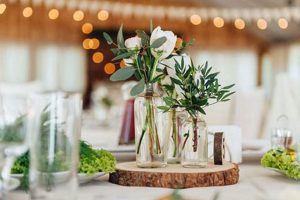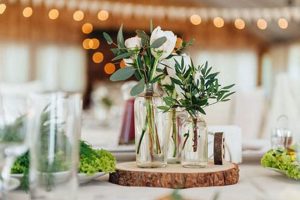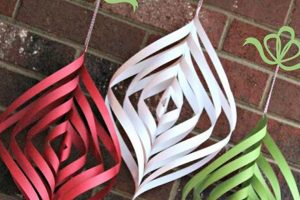Resourceful outdoor ornamentation, crafted from inexpensive or repurposed materials by the individual homeowner, defines this category. Examples include planters fashioned from reclaimed tires, sculptures constructed from salvaged metal, or pathways created with repurposed pallets.
This approach to landscaping offers economic advantages, promotes environmental consciousness through material reuse, and allows for personalized creative expression. Historically, such practices were born out of necessity and resource scarcity, evolving into a celebrated avenue for individuality and sustainability.
The following sections will detail specific project ideas, material sourcing strategies, and fundamental construction techniques for achieving visually appealing and cost-effective outdoor spaces.
Enhancing Outdoor Spaces Economically
The following guidelines provide practical strategies for creating visually appealing garden environments without incurring significant financial expenditure.
Tip 1: Repurpose Existing Materials: Evaluate items destined for disposal. Pallets can be transformed into vertical gardens or outdoor furniture. Glass bottles can border garden beds. Used tires can be painted and utilized as planters.
Tip 2: Propagate Plants: Instead of purchasing new plants, propagate existing ones through cuttings, division, or seed collection. This reduces costs and expands garden variety.
Tip 3: Utilize Found Objects: Natural elements such as stones, branches, and pine cones can be incorporated into garden design to add texture and visual interest at no cost. Local parks and natural areas often provide a wealth of these materials (subject to local regulations).
Tip 4: Construct Raised Beds from Reclaimed Wood: Sourcing reclaimed lumber from construction sites or demolition projects provides an affordable material for creating raised garden beds. Ensure the wood is free of harmful chemicals or treatments.
Tip 5: Create Garden Art from Scrap Metal: Salvaged metal pieces can be welded or otherwise assembled into sculptures or decorative elements. Explore local scrapyards or recycling centers for affordable materials.
Tip 6: Design Pathways with Gravel or Mulch: These materials offer a cost-effective alternative to paved pathways. Sourcing them in bulk from local suppliers can further reduce expenses.
Tip 7: Cultivate a Seed Bank: Save seeds from successful harvests for future planting seasons. This reduces reliance on purchased seeds and promotes biodiversity.
Adherence to these strategies facilitates the creation of aesthetically pleasing and functional outdoor spaces while minimizing financial investment. The emphasis remains on resourcefulness, repurposing, and creative utilization of readily available materials.
The subsequent sections will explore project-specific instructions and advanced techniques for maximizing the impact of low-cost garden embellishments.
1. Resourcefulness
Resourcefulness constitutes a cornerstone principle in the realm of cost-effective, self-executed garden ornamentation. It dictates the efficient and innovative utilization of readily available materials, often diverting items from waste streams to serve decorative or functional purposes within the garden environment. The absence of resourcefulness necessitates reliance on commercially produced items, directly conflicting with the cost-minimization objectives inherent in this category. For example, constructing a raised garden bed from reclaimed shipping pallets, as opposed to purchasing a pre-fabricated kit, exemplifies resourceful material deployment, resulting in significant cost savings.
The importance of resourcefulness extends beyond mere financial considerations. It promotes sustainable practices by minimizing consumption and reducing waste. A garden sculpture created from salvaged metal scraps, for instance, not only avoids the purchase of new materials but also diverts these items from landfills, contributing to environmental conservation. Furthermore, resourcefulness encourages creative problem-solving and fosters a deeper connection to the garden environment, as individuals are challenged to identify and repurpose materials in imaginative ways.
In summary, resourcefulness is indispensable for achieving truly economical and environmentally conscious garden embellishments. Its practical application transforms discarded materials into valuable assets, reducing expenses while fostering creativity and promoting sustainable practices. Overcoming the challenge of initial planning, such as identifying potential materials and conceptualizing their transformation, unlocks the full potential of low budget do-it-yourself garden projects.
2. Creativity
Creativity acts as the catalyst transforming readily available, often inexpensive, materials into aesthetically pleasing and functional garden features. The absence of inventive design and construction hinders the ability to effectively utilize low-cost resources. The direct effect is a higher reliance on purchased, prefabricated items, negating the financial advantages of do-it-yourself construction. A concrete block, typically viewed as a utilitarian building material, can, with creative application, become a modern planter or a modular seating element. The repurposing of glass bottles into a decorative garden border, requiring only imagination and basic assembly, demonstrates the transformative power of creative thinking.
Creativity impacts not only the aesthetic quality but also the functionality of garden elements. For example, a collection of mismatched, reclaimed wooden planks, conceived and assembled with creativity, can form a unique and personalized privacy screen. The simple act of painting discarded tires in vibrant colors instantly converts them into whimsical planters, enhancing visual appeal. The creation of vertical gardens from repurposed pallets utilizes vertical space efficiently, demonstrating practical creativity. These endeavors illustrate the pivotal role of creative thinking in overcoming material limitations, achieving functional utility, and establishing distinctive visual character.
Ultimately, creativity underpins the entire process of economical garden ornamentation. It empowers individuals to envision alternative uses for commonplace items, thereby reducing expenditure and minimizing environmental impact. While readily available materials represent the foundation of these projects, creativity is the architect, designer, and construction crew, orchestrating their transformation into functional and visually compelling garden elements. Overcoming the initial inertia of reimagining familiar objects unlocks the potential for personalized and cost-effective garden design.
3. Sustainability
Sustainability, in the context of low budget DIY garden decor, represents a multifaceted approach centered on minimizing environmental impact and maximizing resource utilization. Its integration into the design and execution of garden ornamentation projects yields ecological and economic benefits.
- Material Repurposing and Waste Reduction
Repurposing existing materials, such as reclaimed wood, recycled plastics, or discarded metal, directly reduces demand for newly manufactured goods. This, in turn, minimizes the energy consumption and pollution associated with resource extraction and manufacturing processes. Examples include creating planters from used tires or constructing garden edging from repurposed glass bottles. The implications encompass a diminished carbon footprint and reduced landfill waste.
- Reduced Consumption of New Resources
Opting for DIY solutions constructed from salvaged materials decreases the need to purchase new items. This conserves virgin resources, such as timber, minerals, and petroleum-based products, and alleviates the environmental burden associated with their extraction, processing, and transportation. Using compost generated from kitchen scraps as fertilizer, rather than purchasing commercially produced fertilizers, illustrates this facet. The resulting benefit includes conservation of natural resources and reduction of the energy-intensive fertilizer production cycle.
- Promotion of Local and Sustainable Material Sourcing
Prioritizing locally sourced materials reduces transportation distances and supports local economies. Employing sustainably harvested wood or stone from nearby quarries minimizes the environmental impact associated with long-distance transport and potentially unsustainable extraction practices. Utilizing locally sourced, untreated lumber for raised bed construction is a practical example. The consequence is a reduced carbon footprint and enhanced support for regional businesses and ecological preservation.
- Minimizing Environmental Harm from Decor Choices
Selecting non-toxic paints, finishes, and construction materials ensures that garden decor does not leach harmful chemicals into the soil or air. Avoiding pressure-treated lumber containing arsenic or chromium, and instead opting for naturally rot-resistant wood or non-toxic sealants, is crucial. The positive outcome is the preservation of soil health, prevention of water contamination, and protection of beneficial insects and pollinators.
The incorporation of sustainable practices into low budget DIY garden decor transcends mere cost savings. It represents a commitment to environmental stewardship, resource conservation, and the minimization of ecological harm. By consciously selecting materials and methods that prioritize sustainability, individuals can create aesthetically pleasing and functional garden spaces while contributing to a healthier planet.
4. Personalization
Personalization constitutes a central tenet within the realm of economical, self-constructed garden ornamentation. The intrinsic connection lies in the ability to tailor the aesthetic and functional aspects of the garden to reflect individual preferences and needs, circumventing the limitations imposed by mass-produced, commercially available products. The absence of personalization reduces garden decor to generic conformity, undermining the opportunity for unique expression. A garden adorned with planters painted in personally selected colors, incorporating stencils reflective of individual interests, exemplifies personalized aesthetics. Conversely, reliance on identical, store-bought decorations results in a standardized, impersonal outdoor space.
The practical significance of personalization extends beyond mere visual appeal. Customized garden features can address specific functional requirements, such as raised beds designed to accommodate physical limitations or trellises tailored to support specific plant varieties. For instance, an individual with mobility challenges might construct elevated planters to facilitate easier gardening, whereas a plant enthusiast might fabricate a custom-designed trellis to optimize sunlight exposure for climbing plants. Furthermore, the creation process itself fosters a sense of ownership and connection to the garden, enhancing the overall gardening experience. A mosaic pathway created with found objects and personal mementos transforms a mundane walkway into a visual narrative, reflecting the homeowner’s life experiences and artistic sensibilities.
In summary, personalization is integral to the successful implementation of low budget DIY garden decor, enabling the creation of unique, functional, and aesthetically pleasing outdoor spaces. Its integration into the design process empowers individuals to express their creativity, address specific needs, and foster a deeper connection to their garden environment. Overcoming the fear of experimentation and embracing individual artistic expression unlocks the full potential of personalized garden ornamentation. The resulting garden becomes a true reflection of the homeowner’s personality, rather than a mere collection of commercially produced items.
5. Material Sourcing
Material sourcing constitutes a critical determinant in the feasibility and cost-effectiveness of low budget do-it-yourself garden decor. The ability to secure suitable materials at minimal or no cost directly impacts project affordability and overall viability. Inefficient or expensive material acquisition negates the financial advantages inherent in self-constructed garden ornamentation. For example, constructing a raised garden bed with reclaimed lumber obtained at no cost from a construction site yields significant savings compared to purchasing new lumber from a retail supplier. The inverse scenario, relying solely on new materials purchased at retail prices, elevates project expenses, diminishing the attractiveness of the do-it-yourself approach. Thus, effective material sourcing is the primary cause for a project to be actually low budget.
Strategic material procurement strategies encompass several key approaches. Firstly, resourcefulness dictates the utilization of existing or discarded items, such as repurposing used tires as planters or transforming glass bottles into garden edging. Secondly, salvaged materials obtained from construction sites, demolition projects, or community recycling centers present cost-effective alternatives to purchasing new supplies. Thirdly, the exploration of free or low-cost resources, such as fallen branches, rocks, or collected seeds, from natural environments, subject to local regulations, can supplement material needs. Furthermore, community-based material exchange programs or online classifieds often provide opportunities to acquire materials at reduced prices or without charge. These methods highlight the practical application of efficient acquisition of materials.
In summary, astute material sourcing is essential for successful low budget DIY garden decor. It dictates the economic viability of projects and promotes sustainable practices through resource repurposing and waste reduction. Overcoming the challenges of locating and acquiring suitable materials through resourcefulness and community engagement maximizes the benefits of this approach, resulting in cost-effective and environmentally responsible garden embellishments. The final, attractive and economical result depends on the correct, conscious and creative approach to acquire the materials.
Frequently Asked Questions
The following addresses common inquiries concerning the creation of economical, self-made garden ornamentation, providing detailed explanations and practical considerations.
Question 1: What are the primary advantages of choosing low budget DIY garden decor over commercially available options?
This approach offers cost savings, personalized design, and promotes environmental sustainability through material repurposing. It allows for the creation of unique outdoor spaces reflecting individual creativity while minimizing financial investment.
Question 2: What types of materials are best suited for low budget DIY garden decor projects?
Reclaimed wood, recycled plastics, salvaged metal, discarded tires, and natural elements like stones and branches are suitable. The primary consideration is the material’s durability, availability, and compatibility with the intended application.
Question 3: How can the costs associated with DIY garden decor be effectively minimized?
Prioritize repurposing existing materials, sourcing free or low-cost resources from local communities, and utilizing efficient construction techniques. Careful planning and strategic material acquisition are essential for minimizing expenses.
Question 4: What safety precautions should be observed when undertaking DIY garden decor projects?
Wear appropriate protective gear, such as gloves and eye protection, when handling tools and materials. Ensure proper ventilation when working with paints or adhesives. Observe all safety guidelines associated with power tools and equipment.
Question 5: How can the longevity and durability of DIY garden decor projects be ensured?
Select weather-resistant materials, apply protective coatings or sealants, and implement proper construction techniques. Regular maintenance, such as cleaning and re-sealing, can extend the lifespan of DIY garden features.
Question 6: What are some potential sources for inspiration and project ideas for low budget DIY garden decor?
Online resources, gardening publications, community workshops, and personal observation of existing garden designs can provide inspiration. Experimentation and adaptation of existing ideas are encouraged.
In summary, low budget DIY garden decor combines resourcefulness, creativity, and sustainability to create personalized outdoor spaces without significant financial expenditure. Careful planning, strategic material sourcing, and adherence to safety guidelines are crucial for success.
The following section will address advanced techniques and project examples to further enhance the application of economical garden embellishment strategies.
Conclusion
The preceding analysis has illuminated the multifaceted nature of economical, self-made garden ornamentation. It has demonstrated that through resourcefulness, creativity, sustainable practices, personalization, and strategic material sourcing, aesthetically pleasing and functional outdoor spaces can be achieved without substantial financial investment. The presented strategies offer a viable alternative to commercially produced garden decor, promoting both economic savings and environmental responsibility.
The principles and techniques detailed herein provide a foundation for individuals to transform their outdoor environments in a cost-effective and personally meaningful manner. Embracing this approach fosters a deeper connection to nature, encourages creative expression, and contributes to a more sustainable future. Continued exploration and application of these concepts will undoubtedly yield innovative and impactful results in the realm of garden design.







